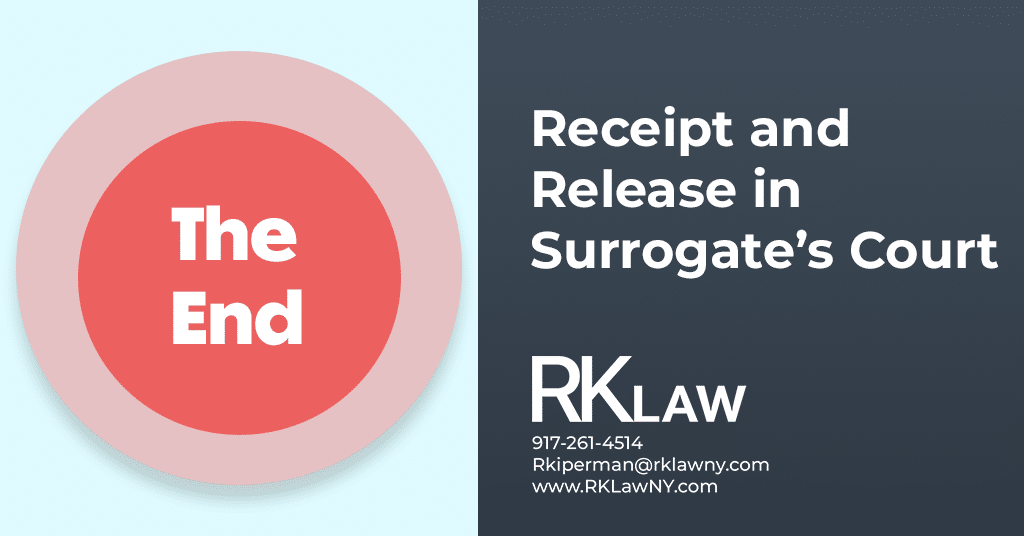A Receipt and Release is necessary to bring finality in Probate and Administration Proceedings
Probate proceedings can be lengthy and complex, but they culminate in the distribution of a deceased person’s estate to their heirs and beneficiaries. An essential step in this process is obtaining a “receipt and release” document. This blog post explores what these documents are, why they’re important, and how they factor into the probate process.
The Bird’s Eye View of Probate
Probate is the legal process through which a deceased person’s estate is settled. It involves validating the Last Will and Testament (if one exists), appointing an Executor or Administrator, identifying and valuing assets, paying debts and taxes, and distributing the remainder to beneficiaries.
What Are Receipt and Release Documents?
Receipt and release documents are legal forms that acknowledge receipt of property or assets from the estate. They also release the executor or administrator from further liability regarding the distributed assets.
Essentially, these documents confirm that a beneficiary has received their inheritance and agrees not to pursue further claims against the executor or the estate.
Why Are Receipt and Release Documents Important?
Receipt and release documents serve several key purposes:
– Closure for the Executor: Once these documents are signed, the executor is typically released from further responsibilities or liabilities related to the distributed assets. This provides a level of protection against future claims or disputes.
– Finality for the Probate Process: With all beneficiaries acknowledging receipt of their inheritance, the probate process can move toward final closure.
– Reduced Risk of Disputes: These documents help minimize the risk of future litigation or disputes regarding estate distribution.
-Informal Estate Settlement: These documents are an informal way to settle the estate, thereby avoiding the time and expenses of a judicial settlement of your account.
When Are Receipt and Release Documents Used?
These documents are typically used at the end of the probate process, when the executor is ready to distribute the estate’s assets to the beneficiaries. Before distribution, the executor will ensure all debts, taxes, and other obligations have been settled. Once this is done, beneficiaries receive their inheritance along with the receipt and release forms to sign.
Filing Receipt and Release Forms
After obtaining signed receipt and release documents from all beneficiaries, the executor typically files them with the Surrogate’s court. This filing confirms that the beneficiaries have accepted their shares of the estate and that the executor is discharged from further duties or liabilities.
What if Beneficiaries Refuse to Sign?
If a beneficiary refuses to sign the receipt and release, that is a signal that something may be wrong with the accounting or the performance of the fiduciary. In such a case, if the dispute cannother otherwise be resolved, a beneficiary may compel an accounting or require the fiduciary to judicial settle their affairs.
Once an accounting is compelled, there may be additional litigation, such as pre objection discovery on the accounting proceeding.
Considerations for Executors and Beneficiaries
– Executors: It’s essential to keep accurate records throughout the probate process to ensure a smooth distribution. Work with legal counsel to ensure that all legal requirements are met and that the receipt and release forms are properly drafted and executed.
– Beneficiaries: Before signing the receipt and release forms, review the estate’s accounting and ensure you understand what you’re entitled to receive. If you have concerns, consult with an attorney before signing.
Conclusion
Receipt and release documents play a critical role in closing a probate proceeding. By acknowledging receipt of assets and releasing the executor from further liability, these documents help ensure a smooth and final resolution to the estate’s administration. If you’re involved in a probate process, understanding the significance of these documents can help you navigate the final stages with confidence.
This structure covers the essential aspects of receipt and release in probate proceedings and provides helpful insights for executors and beneficiaries. If you’d like more details on a specific section or need further assistance, I’m here to help.
For more information, please contact NYC Probate Litigation, Guardianship, NYC Probate and Estate Planning attorney Regina Kiperman:
Phone: 917-261-4514
Fax: 929-556-2089
Email: rkiperman@rklawny.com
Or visit her at:
40 Wall Street
Suite 2508
New York, NY 10005
Visit Regina on LinkedIn
Visit Regina on Facebook
This page is made available by the lawyer for educational purposes only as well as to give you general information and a general understanding of the law, not to provide specific legal advice. By using this site you understand that there is no attorney client relationship between you and the lawyer. The post should not be used as a substitute for competent legal advice from a licensed professional attorney in your state. ATTORNEY ADVERTISING.
